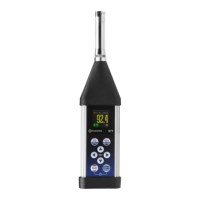#2 function enables one to read out the current measurement results from the selected profile.
#2 function has the format defined as follows:
#2 [,<aver>] [,<profile>] [[[ ,X? ] ,X? ] ,(...) ];
where:
<aver> – type of results:
i – instantaneous results, i.e. results from the current cycle (default),
a – averaged results, i.e. results from the previous cycle,
<profile> – profile number:
1, 2 or 3 – one of the profile, i.e. only results from the given profile will be sent;
X – code of the specified result (see below); if no codes are specified all results will be sent;
In the case of <profile> = 1, 2 or 3 the instrument sends results in the format defined as follows:
#2 [,<aver>],<profile>,Xccc,(...);
where ccc is the value of the result X or question mark (?) if result X is not available;
If no results are available, the instrument returns:
#2,?;
The X codes of the results from the SLM mode are defined as follows:
v under-range flag (ccc equals to 0 when the overload did not occur, 2 when the under-range took place
during the last measurement period but did not occur in the last second of the measurement and 3
when the under-range took place during the last measurement period and it lasted in the last second
of the measurement);
V overload flag (ccc equals to 0 or 1);
T time of the measurement (ccc – value in seconds);
x start date of the measurement in format dd/mm/yyyy (dd – day, mm – month, yyyy - year)
t start time of the measurement in format hh/mm/ss (hh – hour, mm – minute, ss - second)
P Lpeak value (ccc – the value in dB);
M Lmax value (ccc – the value in dB);
N Lmin value (ccc – the value in dB);
S L result (ccc – the value in dB);
R Leq result (ccc – the value in dB).
U LE result (ccc – the value in dB);
B(k) Lden result (ccc – the value in dB; k – flag determining the kind of the result);

